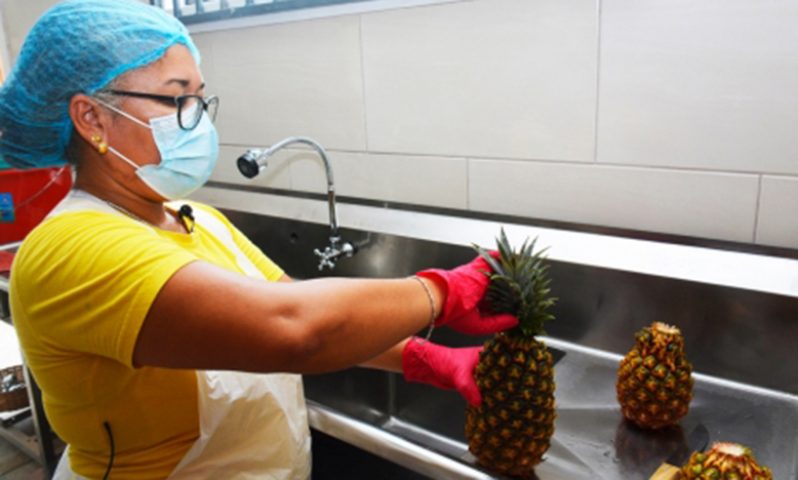WITH its sandy white soil, Suriname’s savannah belt, tucked between the country’s Atlantic coast and the dense tropical forest of its interior, may not count among its most fertile soils. But it’s considered one of the birthplaces of the pineapple, and its rich and unique collection of varieties testifies to this.
Cultivated mainly by the region’s Indigenous Peoples, especially the Lokono (Arawak) and Kaliña (Caraiben) peoples, the pineapple offers great prospects for improving livelihoods – potential which FAO and its United Nations partner agencies are working to help unlock.
“Pineapple cultivation is indispensable in our culture because it has been passed down from generation to generation,” said Wendolien Sabajo from the Lokono (Arawak) community. But only using the traditional methods, the crop is “not so easy to expand. The demand for pineapple is big, but the supply is low.”
“I can’t provide the market enough pineapples,” said Jerry Birambi. Added to that, “Access to finance is very difficult. I cannot get a loan, because we as Indigenous Peoples don’t have property rights on the land. It’s collective rights from the tribe.”
As in most cases across the world, Indigenous Peoples’ territories in Suriname are managed collectively in connection with the well-being, identity and food system of the communities that inhabit these areas.
For all its rich pineapple heritage, Suriname remains a small and largely seasonal producer, with few value-added products and limited exports. To help change that, FAO, the United Nations Industrial Development Organisation (UNIDO), the United Nations Population Fund (UNFPA) and the International Labour Organisation (ILO) are working together with Indigenous Peoples on upgrading the pineapple value chain, from production to consumption.

The project, which is part of the global Agrifood Systems Transformation Accelerator (ASTA) programme co-led by FAO and UNIDO, brings together a diverse range of actors including Indigenous Peoples, producers, processors, traders, input providers as well as government ministries, village authorities, the Organisation of Cooperating Indigenous villages, research institutes and financial institutions.
The ultimate goal is to boost pineapple production from the current 2,000 – 3,000 tonnes a year to 20,000 by 2030. This modern organic vision will need at least five new processing facilities to be set up, targeting three-quarters of production for export markets and one-quarter for local consumers.
Claudia Maatsen, a Caraiben Indigenous woman from the Pierre Kondre Kumbasi village, is now the Chair of a women’s co-operative that produces pineapples and processes them into different products like pineapple juice, syrup and jam. She comments, “The problem we faced in our village is that sometimes the buyers failed to show up and the pineapples had to be thrown away.”
But this should be a thing of the past with the new production co-operatives supported by the project. Up to 300 different products can be made from the pineapple so there is no need for waste if they are not sold whole and fresh. The aim of the initiative is in fact to develop the production and marketing potential of the fruit more fully.
Overall, this heightened production is expected to generate at least US$10 million from increased quantities of fruit and pineapple products per year and create 1,000 new jobs in production, processing and supporting activities that will be promoted especially for rural women and youth.
“The local market is our main goal right now, but we think big, so we definitely want to export to foreign markets,” said Claudia.
NOWHERE ELSE ON THE PLANET
One of the first concrete steps taken by the project has been developing farming training materials for Indigenous Peoples, building off of Costa Rica’s experience in organic pineapple production. The next step is fostering collaboration with international financial institutions to bring in the necessary finance and the last step is a scientific analysis by FAO of the varieties grown and the soils that produce them to optimise the products for the market.
“You have several main opportunities linked to this value chain: more than 15 unique pineapple varieties that you cannot find anywhere else on the planet. In addition, Indigenous Peoples don´t use any chemical inputs in their farming, which means that the traditional pineapple production is organic. This competitive advantage should enable local actors to reach high-quality, niche markets,” said FAO value chain expert Aimee Kourgansky.
Another advantage is that there is “strong interest in developing the sector especially from the Indigenous Peoples, who are keen to produce large quantities of high-quality organic pineapples, and from the government, whose national development plan and economic policy calls for diversification,” Kourgansky added.
That will bring benefits on multiple fronts, said ASTA Senior Project Coordinator in Suriname, Swami Girdhari: “Farmers can earn more income so that they can be economically independent.” The project will also create more jobs “on different levels, up to highly skilled labourers, and contribute to the national development and economy in Suriname, also having a positive impact on biodiversity and the environment as well as the social aspect” of supporting the livelihoods of Indigenous Peoples.
In order to make sure the process does not result in the Indigenous Peoples losing out as their unique varieties become more and more popular, the project will also “work towards securing varieties and genetic rights from a legal perspective and mapping out a certification process to protect the varieties’ anticipated competitive advantage,” Kourgansky said.
The future of pineapple cultivation in the area “will surely continue to grow because I already see more young ones heading in that direction,” said Wendolien Sabajo, Captain of Matta, one of the Indigenous Peoples’ villages. That’s also what FAO and its partners are aiming for: to open up wider prospects for a unique and sustainable agricultural sector in the future. (FAO photo)




.png)









